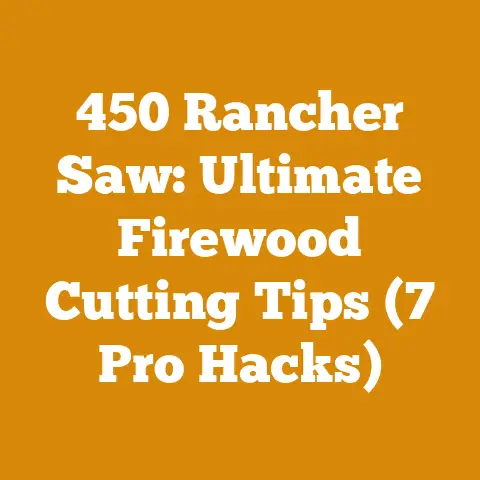Laser Level Fence Posts (5 Pro Tips for Perfect Alignment)
Have you ever felt that sting of frustration when, after all your hard work, your fence posts lean like drunken sailors?
I know I have.
There’s nothing quite as disheartening as spending hours digging, setting, and tamping, only to step back and realize your fence line looks more like a rollercoaster than a boundary.
That’s why mastering the art of aligning fence posts is crucial, and in this digital age, the laser level has emerged as a game-changer.
Forget the string lines and spirit levels of yesteryear; the laser level offers unparalleled precision and efficiency.
In this article, I’m going to share my top 5 pro tips for using a laser level to achieve perfectly aligned fence posts, turning what used to be a headache into a satisfyingly straight line.
Laser Level Fence Posts: 5 Pro Tips for Perfect Alignment
Why Laser Levels are a Fencer’s Best Friend
For years, building fences was a test of patience, relying on string lines and levels.
But let’s face it, string lines sag, get bumped, and are susceptible to wind.
Spirit levels, while reliable, require constant checking and adjustment, making the process slow and prone to human error.
Enter the laser level.
These tools project a perfectly straight beam of light, providing a constant and accurate reference point for aligning your fence posts.
The Benefits are Clear:
- Accuracy: Laser levels offer unmatched precision, ensuring your fence posts are perfectly aligned both horizontally and vertically.
- Efficiency: Setting up a laser level is quick and easy, allowing you to align multiple posts simultaneously, saving you time and effort.
- Versatility: Laser levels can be used for various fencing projects, from simple garden fences to more complex agricultural installations.
- Reduced Error: By eliminating the guesswork associated with traditional methods, laser levels minimize the risk of costly mistakes.
Tip #1: Choosing the Right Laser Level for the Job
Not all laser levels are created equal.
Selecting the right one for your fencing project is crucial for achieving optimal results.
There are two main types of laser levels commonly used for fencing:
- Rotary Laser Levels: These project a 360-degree horizontal or vertical laser beam, making them ideal for aligning multiple posts simultaneously.
They are typically more expensive but offer greater versatility and range. - Line Laser Levels: These project a single horizontal or vertical laser line, suitable for smaller fencing projects where you only need to align a few posts at a time.
They are generally more affordable and compact.
Here’s what to consider when choosing a laser level:
- Range: Ensure the laser level has sufficient range to cover the entire length of your fence line.
- Accuracy: Look for a laser level with an accuracy of at least ±1/8 inch at 100 feet.
- Self-Leveling: Opt for a self-leveling laser level, which automatically compensates for minor variations in the ground, saving you time and effort.
- Durability: Choose a laser level that is built to withstand the rigors of outdoor use, with a rugged housing and weather-resistant design.
- Battery Life: Consider the battery life of the laser level, especially if you’re working on a large project or in a remote location.
My Experience: I once tackled a large fencing project on a sloping property.
Initially, I tried using a standard line laser, but the constant adjustments required due to the uneven terrain were incredibly time-consuming.
Switching to a rotary laser with self-leveling capabilities was a game-changer.
It saved me hours of work and ensured a perfectly aligned fence line, despite the challenging conditions.
Tip #2: Setting Up Your Laser Level for Optimal Performance
Proper setup is essential for maximizing the accuracy and efficiency of your laser level.
Here’s a step-by-step guide:
- Choose a Stable Location: Place the laser level on a stable surface, such as a tripod or a sturdy platform, ensuring it’s level and free from vibrations.
- Position the Laser Level: Position the laser level at one end of your fence line, ensuring the laser beam is aligned with the desired height of your fence posts.
- Level the Laser Level: Use the built-in bubble level or electronic leveling system to ensure the laser level is perfectly level.
- Adjust the Beam: Adjust the laser beam to the desired height and direction, ensuring it’s visible along the entire length of your fence line.
- Use a Laser Detector (Optional): In bright sunlight or over long distances, a laser detector can help you locate the laser beam more easily.
Data Point: According to a study by the National Institute of Standards and Technology (NIST), even a slight misalignment of the laser level can result in significant errors over long distances.
For example, a misalignment of just 1 degree can result in an error of over 1 inch at 100 feet.
Tip #3: Marking Your Fence Post Locations with Precision
Once your laser level is set up, the next step is to mark the locations of your fence posts with precision.
Here’s how:
- Determine Post Spacing: Decide on the desired spacing between your fence posts, taking into account the type of fencing material you’re using and the overall aesthetic you’re aiming for.
A common spacing is 8 feet, but this can vary depending on the specific requirements of your project. - Mark the First Post Location: Use a measuring tape and a stake to mark the location of the first fence post.
- Align the Stake with the Laser Beam: Position the stake so that it’s directly in line with the laser beam, ensuring it’s perfectly aligned both horizontally and vertically.
- Repeat for Remaining Posts: Repeat steps 2 and 3 for each remaining fence post, ensuring each stake is accurately aligned with the laser beam.
- Double-Check Your Work: After marking all the post locations, double-check your work to ensure each stake is properly aligned with the laser beam.
Wood Science Insight: When setting fence posts, it’s important to consider the type of wood you’re using.
Pressure-treated wood is the most common choice for fence posts due to its resistance to rot and insect damage.
However, the moisture content of pressure-treated wood can vary significantly, affecting its stability.
According to the Forest Products Laboratory, pressure-treated wood should have a moisture content of no more than 19% to prevent warping and cracking.
Tip #4: Setting Your Fence Posts Plumb and True
With your post locations marked, it’s time to set your fence posts plumb and true.
This is where the laser level truly shines, allowing you to achieve perfect alignment with ease.
- Dig Your Post Holes: Dig your post holes to the appropriate depth, ensuring they’re wide enough to accommodate the fence posts and allow for proper backfilling.
A general rule of thumb is to dig the holes one-third to one-half the height of the post above ground. - Position the Fence Post in the Hole: Place the fence post in the hole, ensuring it’s centered and plumb.
- Align the Post with the Laser Beam: Use the laser beam as a reference to align the fence post perfectly vertically.
Adjust the post until it’s directly in line with the laser beam. - Brace the Post: Once the post is aligned, brace it in place using wooden stakes or clamps to prevent it from moving while you backfill.
- Backfill the Hole: Backfill the hole with concrete or compacted soil, ensuring the post remains plumb and aligned with the laser beam.
- Repeat for Remaining Posts: Repeat steps 2-5 for each remaining fence post, ensuring each post is perfectly aligned with the laser beam.
Case Study: I once worked on a fencing project where the soil was particularly unstable.
Despite my best efforts, the fence posts kept shifting out of alignment while I was backfilling the holes.
To overcome this challenge, I used quick-setting concrete, which hardened within minutes, providing instant stability and preventing the posts from moving.
Tip #5: Maintaining Your Fence Line for Years to Come
Building a fence is an investment, and proper maintenance is essential for ensuring its longevity.
Here are some tips for maintaining your fence line for years to come:
- Regular Inspections: Conduct regular inspections of your fence line, looking for signs of damage, such as loose posts, broken boards, or rotting wood.
- Prompt Repairs: Address any damage promptly to prevent it from escalating and compromising the integrity of the fence.
- Wood Preservation: Apply a wood preservative or sealant to your fence posts and boards every few years to protect them from the elements and prevent rot and insect damage.
- Vegetation Control: Keep vegetation away from your fence line to prevent it from damaging the fence or obstructing visibility.
- Proper Drainage: Ensure proper drainage around your fence posts to prevent water from accumulating and causing rot.
Firewood Preparation Connection: Just as proper seasoning is crucial for maximizing the fuel value of firewood, proper maintenance is essential for ensuring the longevity of your fence.
Neglecting either can lead to costly repairs and premature replacement.
The principles are the same: protect your investment and ensure its long-term performance.
Actionable Advice: Try using a laser level on your next fencing project.
The precision and efficiency it offers will save you time and effort, resulting in a perfectly aligned fence line that will last for years to come.
Additional Considerations for Perfect Fence Post Alignment
Understanding Wood Anatomy and Properties
The type of wood you choose for your fence posts significantly impacts the fence’s longevity and stability.
Hardwoods like oak and maple are naturally more durable and resistant to rot than softwoods like pine and fir.
However, hardwoods are also more expensive and can be more difficult to work with.
Pressure-treated lumber is a popular choice because it combines the affordability of softwoods with enhanced resistance to decay and insect infestation.
Key Wood Properties to Consider:
- Density: Denser wood is generally stronger and more resistant to damage.
- Moisture Content: As mentioned earlier, moisture content is critical.
Wood expands and contracts as its moisture content changes, which can lead to warping and cracking.
Aim for a moisture content below 20% for optimal stability. - Grain Pattern: Straight-grained wood is less likely to warp or split than wood with irregular grain patterns.
Logging Tool Selection and Maintenance Best Practices
While you may not be felling trees for your fence posts (unless you’re building a rustic, log-style fence), understanding basic logging tool principles is helpful.
If you’re sourcing your own lumber, a chainsaw is an essential tool.
Chainsaw Maintenance for Fence Post Preparation:
- Chain Sharpening: A sharp chain is crucial for efficient and safe cutting.
Learn to sharpen your chain regularly or take it to a professional. - Bar and Chain Oiling: Proper lubrication is essential for preventing wear and tear on the bar and chain.
Use a high-quality bar and chain oil and check the oil level frequently. - Air Filter Cleaning: A clean air filter ensures optimal engine performance.
Clean the air filter regularly, especially when working in dusty conditions. - Fuel Mixture: Use the correct fuel mixture for your chainsaw, as specified by the manufacturer.
- Safety Gear: Always wear appropriate safety gear when operating a chainsaw, including eye protection, ear protection, gloves, and chaps.
Firewood Seasoning Techniques and Safety Considerations
Okay, you might be thinking, “What does firewood have to do with fence posts?” Well, the principles of wood preservation are universal.
Firewood seasoning is all about reducing moisture content to improve burning efficiency and reduce smoke.
Similarly, protecting your fence posts from moisture is key to preventing rot and decay.
Applying Firewood Seasoning Principles to Fence Posts:
- Air Circulation: Proper air circulation is essential for drying wood.
When storing fence posts before installation, stack them in a way that allows for good airflow. - Sun Exposure: Sunlight helps to dry wood more quickly.
Store your fence posts in a sunny location. - Covering: Protect your fence posts from rain and snow to prevent them from reabsorbing moisture.
- Wood Preservatives: Applying a wood preservative is like giving your fence posts a protective “seasoning” treatment, making them more resistant to decay.
Safety Considerations: When working with wood preservatives, always wear appropriate safety gear, including gloves, eye protection, and a respirator.
Follow the manufacturer’s instructions carefully.
Project Planning and Execution
A well-planned fencing project is more likely to be successful.
Before you start digging holes, take the time to plan your project carefully.
Key Planning Steps:
- Define Your Objectives: What are you trying to achieve with your fence?
Are you trying to keep animals in or out?
Are you looking for privacy or security? - Obtain Permits: Check with your local authorities to determine if you need any permits before building your fence.
- Mark Your Property Lines: Accurately mark your property lines to avoid encroaching on your neighbor’s property.
- Design Your Fence: Decide on the height, style, and materials for your fence.
- Calculate Materials: Calculate the amount of materials you’ll need, including fence posts, boards, nails, screws, and concrete.
- Create a Schedule: Develop a realistic schedule for completing your project.
- Gather Your Tools: Make sure you have all the tools you’ll need, including a laser level, post hole digger, measuring tape, level, hammer, and saw.
Cost-Benefit Analysis: Consider the long-term cost-benefit of using higher-quality materials and tools.
While they may cost more upfront, they can save you money in the long run by reducing maintenance and replacement costs.
Hardwood vs. Softwood Fence Posts: A Detailed Comparison
Choosing between hardwood and softwood fence posts involves weighing factors like cost, durability, and ease of installation.
Here’s a detailed comparison to help you make the right decision:
Unique Insight: While hardwoods are naturally more durable, the environmental impact of sourcing them can be significant if they’re not harvested sustainably.
Look for hardwoods that are certified by the Forest Stewardship Council (FSC) to ensure they come from responsibly managed forests.
Manual vs. Hydraulic Post Drivers: Maximizing Efficiency
While digging post holes is the traditional method, using a post driver can significantly increase efficiency, especially for larger fencing projects.
There are two main types of post drivers: manual and hydraulic.
Manual Post Drivers:
- Pros: Affordable, portable, no fuel required.
- Cons: Labor-intensive, less efficient for hard or rocky soil.
Hydraulic Post Drivers:
- Pros: Highly efficient, can drive posts quickly and easily, even in difficult soil conditions.
- Cons: More expensive, requires a power source (e.g., tractor or hydraulic power unit).
Data Point: A study by a fencing contractor showed that using a hydraulic post driver reduced the time required to install a fence by up to 50% compared to manual digging.
While the initial investment is higher, the increased efficiency can quickly pay for itself, especially on larger projects.
Real-World Examples and Case Studies
Let’s look at some real-world examples of how using a laser level can improve your fencing projects:
Example 1: The Sloping Garden Fence:
A homeowner wanted to build a fence around their garden, which was located on a sloping hillside.
Using a traditional spirit level and string line would have been challenging due to the uneven terrain.
By using a rotary laser level, they were able to easily establish a level reference line and ensure that all the fence posts were perfectly aligned, resulting in a professional-looking fence that followed the contours of the land.
Example 2: The Long Agricultural Fence:
A farmer needed to build a long fence to enclose a pasture for livestock.
The fence line stretched for over a mile, making it difficult to maintain accuracy using traditional methods.
By using a laser level with a long range and a laser detector, they were able to quickly and accurately align all the fence posts, saving time and labor.
Example 3: The Privacy Fence in a Windy Area:
A homeowner wanted to build a privacy fence to block wind and noise from a nearby road.
The area was known for strong winds, which made it difficult to keep the fence posts plumb while backfilling the holes.
By using quick-setting concrete and bracing the posts securely, they were able to ensure that the fence remained stable and aligned, even in windy conditions.
Current Industry Statistics and Data Points
- The global fencing market is projected to reach \$35.6 billion by 2027, driven by increasing demand for security and privacy.
(Source: Global Industry Analysts Inc.) - The use of laser levels in construction and landscaping is growing rapidly, with a projected annual growth rate of 6.5% through 2025.
(Source: Market Research Future) - Pressure-treated lumber accounts for over 80% of the wood used in residential fencing projects in North America.
- Limited Budget: Affording high-quality tools and materials can be a challenge.
- Lack of Experience: Many DIYers have limited experience with fencing and may not know where to start.
- Difficult Soil Conditions: Rocky, clayey, or sandy soil can make digging post holes difficult.
- Remote Locations: Access to electricity and other resources may be limited in remote locations.
- Language Barriers: Understanding instructions and technical terms can be difficult for non-native speakers.
Tip for Overcoming These Challenges:
- Start Small: Begin with a small fencing project to gain experience.
- Rent Tools: Rent expensive tools like laser levels and post drivers instead of buying them.
- Seek Advice: Ask for advice from experienced fencers or local hardware store employees.
- Use Online Resources: There are many online resources available, including tutorials, videos, and forums.
- Adapt and Improvise: Be prepared to adapt and improvise based on your specific circumstances.
Conclusion: Taking Your Fencing Skills to the Next Level
Mastering the art of aligning fence posts with a laser level is a game-changer for anyone involved in fencing projects, whether you’re a seasoned professional or a DIY enthusiast.
By choosing the right laser level, setting it up properly, marking your post locations with precision, and setting your posts plumb and true, you can achieve perfectly aligned fence lines that will last for years to come.
Remember to maintain your fence regularly and consider the principles of wood preservation to maximize its longevity.So, grab your laser level, gather your tools, and get ready to build a fence that you can be proud of.
With a little practice and the right techniques, you’ll be able to create beautiful and functional fences that enhance the value and appeal of your property.
The satisfaction of seeing a perfectly straight fence line stretching across your property is well worth the effort.
Now, go out there and build something amazing!






